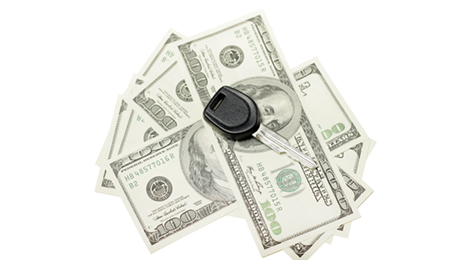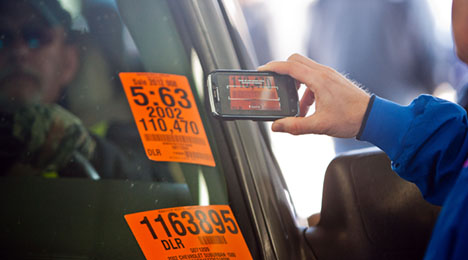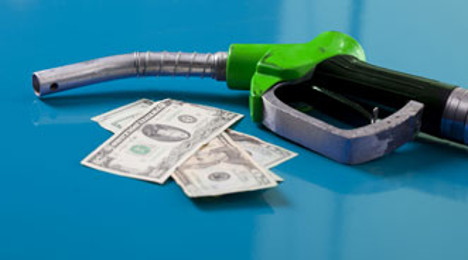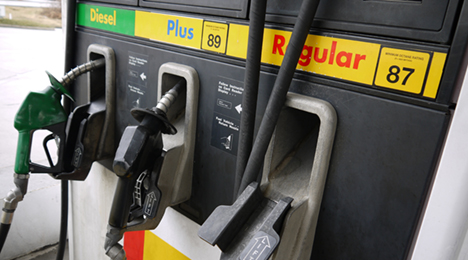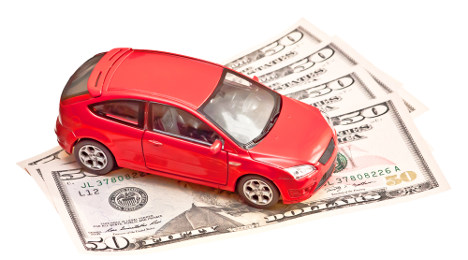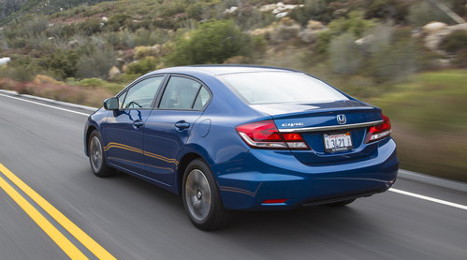So, used-vehicle sales in June were not as strong as they were earlier this spring. But, as ADESA’s Tom Kontos points out, new-car sales were “great.”
And that means more trade-ins for dealers, which tends to bode well on the used-car side of their stores.
“There was a bit of a respite in year-over-year retail used vehicle sales growth after strong months in March, April and May,” Kontos said in his latest monthly commentary on the used-car market.
“June was a great month for new-vehicle sales, however, and the associated trade-in activity should result in some attractive retail units along with additional wholesale supply,” he continued.
Price-wise, the dollars that used cars were fetching in wholesale channels fell a little more month-over-month than they typically do at this point of the year, Kontos pointed out. But June’s wholesale values were still beating year-ago levels by a wide margin.
Specifically, wholesale prices averaged $10,004 for the month, which was 4.7 percent above June 2013 levels and down 3.1 percent month-over-month.
Kontos would note that prices for nearly all model classes were down from May. The most significant depreciation was for midsize SUVs, which were off 10.6 percent.
Year-over-year, it was the opposite scenario. All but two of the segments in ADESA’s data set showed increased prices, with full-size vans leading the pack at 14.8-percent growth.
Kontos also offered a breakdown based on seller type.
“Prices for used vehicles remarketed by manufacturers were actually up 0.6 percent month-over-month (for those units that were not no-saled), though down 0.1 percent year-over-year, reflecting volume pressure. Prices for fleet/lease consignors were down 3.9 percent sequentially and up 2.5 percent annually. Dealer consignors saw a 2.3-percent average price decrease versus May, and a 3.4-percent uptick versus June 2013," he reported.
Used cars are not only more fresh these days, but they're also much more valuable. And this growth in value is showing up in the prices people are willing to pay for these pre-owned vehicles.
In fact, the total value of used cars sold in June was up 17.3 percent from a year ago, according to CNW Market Research, which said average transaction prices on used cars climbed about 17 percent, as well.
“Average transaction prices are up a comfortable 16.7 percent over a year ago as fresher and newer vehicles begin to enter the used-car market,” company president Art Spinella said in his analysis accompanying the firm’s monthly used-car sales roundup.
And this has occurred in light of the fact that there were 7.6 percent fewer used-car shoppers at franchised dealerships in June, 29 percent fewer consumers going to independent stores and 5.6 percent fewer consumers shopping for private-party used-car deals, according to CNW.
Overall, used-car sales in June beat year-ago figures modestly, and both independent and franchised dealers were down more than 5 percent, but year-to-date numbers across the board are edging 2013’s first half.
CNW said there were 4.51 million used cars sold last month, up from 4.49 million in June 2013. Franchised dealers had 1.64 million used sales, compared to 1.74 million a year ago. Independents sold 1.45 million units, down from 1.53 million a year earlier.
There were 1.42 million casual sales in June, a 16.9-percent year-over-year increase.
In the first half of the year, used-car sales totaled 20.34 million vehicles, up from 20.14 million through the first six months of 2013.
Franchised dealers have pulled in 7.34 million used sales, compared to 7.30 million through June 2013. Independents are at 6.67 million, against 6.63 million in the year-ago period.
There were 6.34 million casual sales in the first six months of the year, up from 6.22 million in the same period of 2013.
Even as tax season came to a close, prompting predictions of used-car value drops, Manheim reported Tuesday there was actually an increase in used-vehicle values in the second quarter.
The driver? Consumer demand, says Manheim analysts.
“Strong consumer demand drove an increase in volume and values for used vehicles in the second quarter as attractive financing put purchases within reach of more consumers,” the company reported.
The change was illustrated in the 1-percent spike in the Manheim Used Vehicle Value Index in the second quarter versus Q1 rates.
This translated to a 3.6-percent rise in the index year-over-year.
"While the overall economic picture has been cloudy at times this year, the automotive market has been a consistent bright spot," said Tom Webb, Manheim chief economist. "Consumers may have trouble qualifying for a home loan under today's mortgage requirements, but they have the credit and resources to purchase a car. These favorable auto lending conditions show no signs of letting up in the short-term and should help the used-car market."
Webb explained that the auto market has continued to lead economic recovery in the country, and strong retail demand and favorable credit conditions have continued to support used-car sales and dealer profits — a healthy market environment that has contributed to spikes in used values, even as used supply expands.
These conditions have also led to a change in the market “sweet spot,” Webb explained.
In June, the strongest pricing and lowest relative supply of vehicles in the wholesale market was in the $12,000 to $15,000 price range, according to Manheim data.
Last year, and in early 2014, the strongest pricing was often found in the $8,000 to $10,000 price range, he said.
Breaking it Down by Segment
Looking at wholesale price movement by segment in Q2, pick-ups and vans continued to see the strongest price retention rates.
According to Manheim, this strength has been driven mostly by demand from consumers and businesses for work vehicles, as construction rates continue to rise.
Prices were up 7.5 percent for pickups and 6.8 percent for vans during Q2 on year-over-year basis.
The larger segments continued to lead the pack, as the SUV and CUVs also saw spikes in values in Q2. These segments saw prices increase 2.5 percent over the year-ago period.
Webb contributed the price spike in compact and midsize CUVs to consumers who are looking for vehicles with both space and high fuel efficiency.
Interestingly, one segment that has underperformed this year showed a bit of an improvement in Q2 — perhaps due to rising gas prices.
Compact cars ended June with prices up 3.9 percent year-over-year.
On the other hand, luxury cars showed signs of weakness this past quarter, falling 0.8 percent year-over-year.
It seems this segment is seeing the effects of expanding supply, as well as strong incentives, which are both putting downward pressure on prices.
Lastly, midsize cars — the largest segment of the market — showed a bit of a decline from Q1 tax season values, but prices are still up 4.8 percent from the year-ago period, according to Manheim data.
Supply to Push Prices Down
Though consumer interest may be driving up prices, the trend is not expected to last.
Many have been waiting for expanding used supply, driven by an increase in off-lease vehicles at auction, to push used-car rates down.
According to Manheim’s Webb, it won’t be long.
"An increase in supply of wholesale vehicles will inevitably put downward pressure on pricing," Webb said. "Used-vehicle values shouldn't fall off a cliff, but they likely will decline the rest of the year. This easing of prices should be modest and not disruptive to the efficient functioning of the market."
Besides expanding supply, Q3 is traditionally a slower time for activity on the lots as dealers and manufacturers make way for new models.
Webb also pointed out a longer-than-normal delay this year from rental companies means many of these units will make it into the lanes this summer, also serving to push used prices down a bit.
Editor's Note: Stay tuned to Thursday's Auto Remarketing Today for more insight on Q1 auction price movement from Manheim's Tom Webb.
After high prices stuck around a bit longer than expected in May following the close of tax season, the auction price declines in June more than doubled.
According to Black Book data, prices for vehicles model years 2009-2013 fell an average of 1 percent. This is compared to a decline of 0.4 percent in May.
Black Book analysts said these trends are “signaling typical summertime patterns.”
“The annual depreciation patterns typically see larger value changes in the second half of each year, and we’ve seen this begin to pick up the pace over the last 45-60 days,” said Ricky Beggs, editorial director at Black Book. “We will keep a watchful eye on how gas prices and the new model year impact this pace of depreciation as we head through the summer months.”
Black Book pointed out another trend that points to the summer slowdown: Six vehicle segments, all cars, had a monthly depreciation change higher than 1.5 percent, compared with none at this rate in May.
Those six segments were entry midsize cars (down 2.7 percent month-over-month); compact cars (down 2.5 percent); full-size cars (down 2.4 percent); upper midsize cars (down 1.8 percent); entry-level cars (down 1.8 percent); and sporty cars (down 1.6 percent).
Consistent with trends seen earlier this year, trucks continue to see stronger price retention in the lanes.
Domestic cars fell by an average of 2 percent, while domestic trucks only dropped 0.5 percent.
For foreign automakers, cars saw prices fall by 1.4 percent in June, while import trucks dropped by 0.8 percent.
Along that same trend, the midsize pickup segment held the strongest price retention this past month, with prices actually rising by 1.1 percent.
This is one of three segments that saw a price spikes in June. The midsize pickups were followed by the cargo minivans — which climbed 0.5 percent — and full-size pickups, which rose by 0.1 percent.
Highlighting car segment movement, the premium sporty cars had the strongest month-over-month retention in June among cars, dropping by 0.6 percent.
Black Book pointed out this segment was also the only car segment among the top 12 for strongest price retention rates in June.
The average price for premium sporty cars at the end of June was $49,136, a 12.3-percent drop from year-ago levels ($56,048), according to Black Book data.
On the other end of the spectrum, the entry midsize cars led all car segments for the greatest month-over-month price drop. The segment saw prices fall by 2.7 percent in June.
The average segment price at the end of June was $12,539, an 11.4-percent drop from the same periof of 2013 ($14,155).
Though truck depreciation was much softer overall, compact crossovers and passenger minivans led the truck segments with the largest depreciation rates last month – both segment saw prices fall by 1.4 percent month-over-month.
And the price declines haven’t slowed much this month so far.
According to the latest “Beggs on the Used Car Market” report, auction prices for the car segments dropped an average of $45 last week.
For more on last week’s wholesale price movement, see the below Auto Remarketing story:
1 Car Segment Stands Out in Lanes
It was an abbreviated week in the lanes with the Fourth of July holiday, but prices continued to fall as the market entered the dead of summer.
And following a trend seen this past spring, the car segments continue to see larger declines than the more stable trucks.
According to the latest “Beggs on the Used Car Market” report, auction prices for the car segments dropped an average of $45 last week.
Ricky Beggs, editorial director and senior vice president of Black Book, said this drop is “right around the change levels of the previous nine weeks.”
Beggs pointed out one car segment, in particular, that did stand out.
The entry level cars, which saw no price change two weeks ago, saw the largest decline this past week, percentage-wise, among all the car segments.
Specifically, it had an average drop of 0.52 percent (or $37), he said.
As for the truck segments, Beggs said they “were again slightly more stable than the cars.”
Last week, trucks saw an average drop of $20, which is the lowest weekly change for these large units in the past three weeks.
During his latest report, Beggs also took a moment to honor Ed Bobit, founder of Bobit business media, who recently passed away.
Beggs called Bobit a “true pioneer of the fleet industry.”
“There is no one who was more supportive of the industry and the people of the industry than the Coach. All who had the opportunity to know him will feel the impact of this loss, but also have great memories of his friendship and leadership,” said Beggs. “Keep the stogie lit. Our condolences from Black Book to his family at home, and his family at Bobit Business Media.”
For more on the late head of Bobit Business Media, see the Auto Remarketing story below:
Bobit Business Media Founder Passes Away at 86
To view the latest "Beggs on the Used Car Market," report, see the video above.
It seems interest in hybrid and electric vehicles might be slowing as predictions of more stable gas prices are on the horizon, NADA Used Car Guide analysts pointed out in a recent analysis. .
In fact, according to the latest NADA Perspective report that highlighted hybrid vehicle market performance, hybrid electric vehicle sales are down 10 percent year-to-date. And market share is down, as well, with hybrid share of total new vehicle sales has fallen from 3.1 percent in 2013 to 2.9 percent this year, the report pointed out.
NADA Used Car Guide also reminded us just how connected used hybrid prices are to price changes as the gas pump.
More specifically, the report said, “The recent softness in new hybrid sales and the moderation in used-price depreciation over the past couple of years can largely be tied to relatively consistent gasoline prices and the improved fuel efficiency of ICE models.”
Traditionally, hybrids have depreciated at a much quicker rate than their gas-only counterparts, and this trend isn't expected to slow in coming years.
And even as gas prices remained high this spring and early summer, NADA said consumers seem to have become “desensitized,” and as a result may not be turning to the HEV and EV market.
“Hybrid sales trends of the past few years strongly suggest that consumers have become desensitized to dramatic and rapid changes in gas prices as the occurrences have become more frequent,” NADA said. “Essentially, consumers have adjusted both expectations and household budgets to today’s higher level of fuel prices, to the detriment of hybrid demand. Compounding matters, fuel economy advances in gasoline powered vehicles has cut into the efficiency advantages of hybrids.”
Of course, another element to the lower hybrid used-car sales is the increasingly impressive fuel efficiency of many compact gas-only models.
Looking ahead, the report pointed out that gas prices are expected to dip over the next few years in part due to increased domestic production of crude oil — and consequently, hybrid prices are expected to fall, as well.
“The increase in domestic crude oil production is expected to not only reduce the U.S.’ dependence on imported petroleum, but also keep gasoline prices at or below current levels through 2021,” the analysis noted.
As gas prices are expected to remain stable in coming years, NADA is predicting hybrid depreciation will remain elevated than traditional fuel vehicles.
The report ffered the following example: Trade-in prices for the 2012 Toyota Camry LE hybrid are predicted to fall by 13 percent and 18 percent in 2014 and 2015, respectively.
On the other hand, prices for the gas-only Camry LE are predicted to drop by 8 percent and 13 percent during the same years.
“In closing, hybrids will remain a viable choice for consumers who live in urban areas or those adhering to environmentally-friendly ideals, and Toyota has proven with the Prius that hybrids can be strong performers in both new vehicle sales and used vehicle retention,” the report noted.
But NADA also pointed out that gas price stability will serve to make it more difficult to entice consumers into the hybrid and electric vehicle market.
“However, the likelihood that gas prices will at least remain at current levels near-term, the federally-mandated requirement pushing fuel economy to improve and a lower price point for non-hybrids enhance the practicality of gas-powered vehicles. As a result, hybrids will likely be more challenged to woo new consumers into the EV fold over the coming years,” it said.
As June wrapped up in the lanes, talk of gas prices pervaded the auctions last week.
According to Black Book’s Ricky Beggs, gas prices continued to be the topic of conversation last week as the $3.70 per gallon average was 13 cents higher than year-ago-levels.
The Black Book senior vice president and editorial director highlighted in his latest “Beggs on the Used Car Market” vide report that comments were overheard at auction last week on this topic, such as “gas fumes were on the buyers’ minds”.
And the trend was visible in last week’s price developments, as well.
The more fuel efficient segments saw some of the strongest price retention in the lanes last week.
The overall average decline for cars last week was $53, and the entry level cars were the only segment to see an increase in price.
Beggs also pointed out that the smaller segments have experienced strong price retention for most of this past spring.
“During the most positive adjusting weeks of the spring market in March and April the entry level cars, the compact cars, the entry mid-size cars and the upper mid-size cars were the strongest increasing segments, made up the segments with the lowest average price and also are comprised of the more fuel efficient models,” said Beggs.
On the other hand, trucks saw a slightly larger decline than the previous week, falling by an average of $39. Two weeks ago, the truck segments saw a $34 slide.
Beggs pointed out this past week, trucks saw the largest weekly decline since the week ending Feb. 21
“Even though the trucks have declined less than the cars, we now have a declining truck market for six of the last seven weeks,” Beggs said. “And for the first time in more than three months we had a weekly market with no truck segments actually increasing.”
The compact pickups saw the lowest drop, falling by $13 last week. On the other hand, the luxury SUVs lead the pack for declines, sliding by $104.
To view the latest "Beggs on the Used Car Market" report, see above.
Used car price drops are expected to drop by over 1 percent at auction during this first week of summer.
NADA Used Car Guide’s AuctionNet data indicates used-car prices will drop by 1.1 percent or $175 this week.
Overall losses will be “moderate” said David Paris, automotive analyst at NADA UCG, but a few segments will buck the trend.
The mid-size cars are expected to see average declines of 1.6 percent, followed by compact cars, mid-size vans, compact utilities and large SUVs with losses all larger than 1.1 percent.
“The only segment expected to remain unchanged will be luxury utilities,” said Paris.
Smaller declines are expected in all other segments.
This over 1 percent predicted decline comes on the heels of a another week of softening in the lanes, according to Black Book data.
Last week, only only 28 percent of the price adjustment seen in the lanes were increases — the lowest rate since the week ending Feb. 21, according to Black Book.
Four- and two-week AuctionNet wholesale average prices are created by collecting all AuctionNet records for vehicles up to five years of age for a specified period of time. Prices are then adjusted for changes in mileage and mix.
Current week prices are based on NADA's proprietary used vehicle value model which includes assumptions for new-vehicle prices, used vehicle supply, gasoline prices and other economic factors.

| NADA Segment |
Average AuctionNet® Wholesale Price |
2-Week v. Current |
| 4-Week Average |
2-Week Average |
Current Week |
% Change |
$ Change |
| Compact Car |
$11,200 |
$11,100 |
$10,950 |
-1.4% |
($150) |
| Compact Utility |
$15,100 |
$15,025 |
$14,850 |
-1.2% |
($175) |
| Industry |
$16,075 |
$16,000 |
$15,825 |
-1.1% |
($175) |
| Large Pickup |
$22,750 |
$22,650 |
$22,450 |
-0.9% |
($200) |
| Large SUV |
$28,625 |
$28,400 |
$28,100 |
-1.1% |
($300) |
| Luxury Car |
$21,300 |
$21,250 |
$21,150 |
-0.5% |
($100) |
| Luxury Utility |
$26,150 |
$26,175 |
$26,175 |
0.0% |
$0 |
| Mid-Size Car |
$12,650 |
$12,550 |
$12,350 |
-1.6% |
($200) |
| Mid-Size Utility |
$19,250 |
$19,050 |
$18,900 |
-0.8% |
($150) |
| Mid-Size Van |
$15,850 |
$15,750 |
$15,550 |
-1.3% |
($200) |
A number of variables contributed to price softening in the lanes last week, one of which was a curveball thrown from Mother Nature, herself.
Black Book’s Ricky Beggs pointed out in his latest “Beggs on the Used Car Market” report that vehicle damage from a group of storms — which produced tornadoes and hail that whipped past the Denver airport a few weeks ago and toward the auctions in Aurora, Colo. — had an impact on prices in the lanes last week.
“Well, this past week a significant number of the damaged cars from that day of storms made it to the local auctions,” said Beggs, editorial director and senior vice president at Black Book. “Even though the market activity was pretty solid, some of the values reflected the existing dings that covered many of the cars and trucks.”
Taking a look at auction price movement last week, the number of price changes sat at 1,318, the lowest number this month.
Of those changes, only 28 percent were increases — the lowest rate since the week ending Feb. 21.
That said, the car segments are performing a bit better, Beggs shared, with an average decline of $45, the smallest seen this month.
Though it continues to see better price retention than cars, the truck market has seen its weekly decline increase each week in June.
Last week, the average decline for trucks was $34. And for the first time in the last three month, full-size pickups did not increase in price, showing no change from rates seen two weeks ago.
Another trend pushing prices down at auction: expanding supply. Beggs said this trend is also allowing dealers to be a bit more selective at auction, perhaps pushing sales rates down right along with prices.
“Add in the traditional and expected seasonal summer softening and the comments such as ‘downtime in the business’ and the feeling that the buyers are in a ‘wait-and-see attitude’ goes right along with several reports that referenced that prices seem to be leveling off and adjusting down,” said Beggs.
To view the latest "Beggs on the Used Car Market" report, see the video above.
How much will my car get me as a trade-in when I’m ready for a new ride? This is top-of-mind for many consumers that enjoy switching their wheels out every few years.
Dealers might want to point out Honda and its sister brand, Acura, to these shoppers — they just won the top spots in Edmunds.com’s fourth annual Best Retained Value Awards.
Honda won for the non-luxury vehicles, with a projected 50.1 percent residual value after five years.
Acura saw similar results, topping the luxury list with a projected five-year residual value of 45.4 percent.
Officials from Edmunds point out that this is the third time that each brand has secured the top prize since the site first launched the awards in 2011.
"For many shoppers, the long-term value of a car is one of the biggest deciding factors when they're comparing brands and models," says Edmunds.com director of remarketing Joe Spina. "Edmunds.com's Best Retained Value Awards make it easier for shoppers to identify the best return on their purchase if and when they decide to sell it down the road."
The awards recognize the brands and 2014 models that have the highest projected residual values after five years based on their average "cash" True Market Value price during their first five months in the market (or, for vehicles introduced in November or December of 2013, through March 2014).
Another Japanese automaker dominated the model-level awards: Toyota, which claimed the most model winners with six awards.
A full list of all 27 model winners can be found below:
|
2014 Edmunds.com Best Retained Value Awards
Model-Level Winners
|
| |
|
Category
|
Make
|
Model
|
Retained
Value^
|
|
Compact Sedan
|
Honda
|
Civic
|
52.2%
|
|
Luxury Compact Sedan
|
Acura
|
ILX
|
46.5%
|
|
Midsize Sedan
|
Nissan
|
Altima
|
47.3%
|
|
Luxury Midsize Sedan
|
Acura
|
TSX
|
45.4%
|
|
Large Sedan
|
Toyota
|
Avalon
|
43.3%
|
|
Luxury Large Sedan
|
Porsche
|
Panamera
|
44.4%
|
|
Compact Wagon
|
Scion
|
xB
|
48.4%
|
|
Midsize/Large Wagon
|
Toyota
|
Venza
|
50.2%
|
|
Luxury Wagon
|
Acura
|
TSX Sport Wagon
|
44.7%
|
|
Compact Coupe
|
Subaru
|
BRZ
|
51.9%
|
|
Luxury Compact Coupe
|
Porsche
|
911
|
48.5%
|
|
Midsize/Large Coupe
|
Dodge
|
Challenger
|
55.0%
|
|
Luxury Midsize Coupe
|
Cadillac
|
CTS-V Coupe
|
46.6%
|
|
Compact Convertible
|
MINI
|
Cooper Roadster
|
45.9%
|
|
Luxury Compact Convertible
|
Porsche
|
911
|
47.5%
|
|
Midsize Convertible
|
Chevrolet
|
Camaro
|
46.7%
|
|
Luxury Midsize Convertible
|
Audi
|
A5
|
45.6%
|
|
Compact Truck
|
Toyota
|
Tacoma
|
61.6%
|
|
Large Truck
|
Toyota
|
Tundra
|
55.4%
|
|
Large Heavy Duty Truck
|
Ford
|
F-350 Super Duty
|
56.8%
|
|
Compact SUV
|
Jeep
|
Wrangler
|
56.9%
|
|
Midsize SUV
|
Toytota
|
FJ Cruiser
|
60.9%
|
|
Luxury Compact/Midsize SUV
|
BMW
|
X6
|
48.5%
|
|
Large SUV
|
Toyota
|
Sequoia
|
49.2%
|
|
Luxury Large SUV
|
Audi
|
Q7
|
44.0%
|
|
Minivan
|
Honda
|
Odyssey
|
47.8%
|
|
Commercial Van
|
Ram
|
Promaster Cargo Van
|
42.7%
|
| |
|
|
|
|
^ – Retained Value is the projected private party resale value after five years in the market and assuming 15,000 miles driven per year, expressed as a percentage of the True Market Value price when sold new.
|


